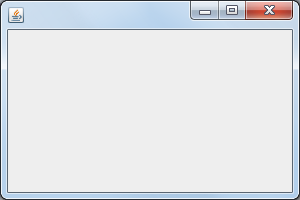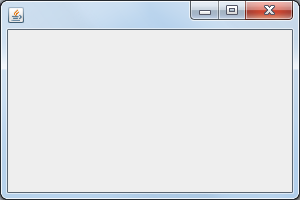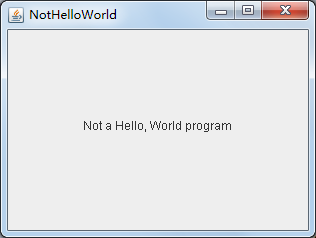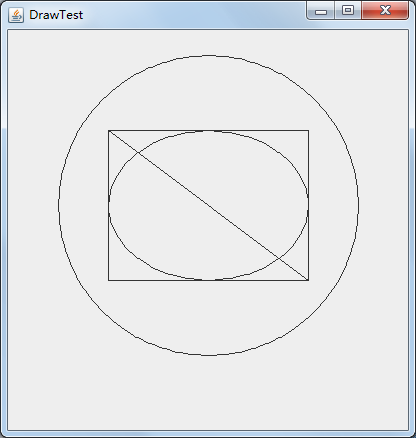第十二周学习总结
一 . 理论部分
1.概述:用户界面,用户与计算机系统(各种程序)交互的接口
图形用户界面,以图形方式呈现的用户界面
2.AWT:Java的抽象窗口工具箱,它包含在java.awt包中,提供了许多用来设计GUI的组件类和容器类
AWT库处理用户界面元素的方法:把图形元素的创建和行为委托给本地的GUI工具箱进行处理
3.Swing:在java.swing包中,Swing用户界面库是非基于对等体的GUI工具箱
4.AWT与Swing的关系:(1)大部分AWT组件都有其Swing的等价组件
(2)Swing组件的名字一般是在AWT组件名前面添加一个字母“J”,如:JButton,JFrame,JPanel等
5.创建框架:
(1)组件:通常把由Component类的子类或间接子类创建的对象称为一个组件
(2)容器:Java中呢容纳和排列组件的组件,通常的容器是框架
(3)添加组件:Container类提供了一个方法add(),用来在容器类组件对象中添加其他组件
6.框架(Frame)的创建:
(1)创建空框架:在Java中,常采用框架(Frame)创建初始界面,即GUI的顶层窗口;AWT库中有一个基于对等体的Frame类;该类的Swing版本为JFrame,JFrame是Frame子类
(2)框架定位与框架属性:
定位:常用Component类的setLocation和setBounds方法
常用属性:Title(框架标题);IconImage(框架图标)
(3)确定框架大小:通过调用Toolkit类的方法来得到屏幕尺寸信息
7.在组件中显示信息:
(1)在AWT中可调用add()方法把组件直接添加到AWTFrame中,在Swing中组件则添加到内容窗格里。其中内容窗格是用来添加组件的,添加代码如下:
Container contentPane = getContentPane();
(2)用户也可以自行创建一个组件类,并在组件上进行绘制,此时需要重载paintComponent(),用户的自建组件也可添加到内容窗格里
(3)public void setEnabled(boolean b):设置组件是否可被激活
当参数b取值true时,组件可以被激活;当参数b取值false 时,组件不可激活;默认情况下,组件是可以被激活的
(4)public void setVisible(boolean b):设置组件在该容器中的可见性
当b取值true时,组件在容器中可见;当b取值false时,组件在容器中不可见;除了Window型组件外,其它类型组件默认是可见的
二 .实验部分
1、实验目的与要求
(1) 掌握Java GUI中框架创建及属性设置中常用类的API;
(2) 掌握Java GUI中2D图形绘制常用类的API;
(3) 了解Java GUI中2D图形中字体与颜色的设置方法;
(4) 了解Java GUI中2D图像的载入方法。
2、实验内容和步骤
实验1: 导入第10章示例程序,测试程序并进行代码注释。
测试程序1:
l 运行下列程序,观察程序运行结果。
import javax.swing.*;
public class SimpleFrameTest
{
public static void main(String[] args) { JFrame frame = new JFrame(); //创建一个frame类对象 frame.setBounds(0, 0,300, 200);//定义坐标以及宽度和高度 frame.setDefaultCloseOperation(JFrame.EXIT_ON_CLOSE);//窗口关闭操作 frame.setVisible(true);//窗口是否可见 } }
程序运行结果如下: 
在elipse IDE中调试运行教材407页程序10-1,结合程序运行结果理解程序;与上面程序对比,思考异同;
l 掌握空框架创建方法;
l 了解主线程与事件分派线程概念;
l 掌握GUI顶层窗口创建技术。
package simpleFrame;
import java.awt.*;
import javax.swing.*;
/**
* @version 1.33 2015-05-12
* @author Cay Horstmann
*/ public class SimpleFrameTest { public static void main(String[] args) { EventQueue.invokeLater(() ->//lambda表达式:通过线程开启一个队列 { SimpleFrame frame = new SimpleFrame();//创建一个类对象 frame.setDefaultCloseOperation(JFrame.EXIT_ON_CLOSE);//设置对象点击关闭操作 frame.setVisible(true);//页面是否可见 }); } } class SimpleFrame extends JFrame { private static final int DEFAULT_WIDTH = 300; private static final int DEFAULT_HEIGHT = 200; public SimpleFrame()//构造器 { setSize(DEFAULT_WIDTH, DEFAULT_HEIGHT);//设置大小 } }
程序运行结果如下:

测试程序2:
l 在elipse IDE中调试运行教材412页程序10-2,结合程序运行结果理解程序;
掌握确定框架常用属性的设置方法。
package simpleFrame;
import java.awt.*;
import javax.swing.*;
/**
* @version 1.34 2015-06-16
* @author Cay Horstmann
*/ public class SizedFrameTest { public static void main(String[] args) { EventQueue.invokeLater(() ->//lambda表达式:通过线程开启一个队列 { JFrame frame = new SizedFrame();//创建一个frame类对象 frame.setTitle("SizedFrame");//设置标题 frame.setDefaultCloseOperation(JFrame.EXIT_ON_CLOSE);//关闭操作 frame.setVisible(true);//设置可见性 }); } } class SizedFrame extends JFrame//继承 { public SizedFrame()//构造器 { //得到屏幕维度 Toolkit kit = Toolkit.getDefaultToolkit();//生成Toolkit对象 Dimension screenSize = kit.getScreenSize(); int screenHeight = screenSize.height; int screenWidth = screenSize.width; // set frame width, height and let platform pick screen location setSize(screenWidth / 2, screenHeight / 2);//尺寸大小 setLocationByPlatform(true); // set frame icon Image img = new ImageIcon("icon.gif").getImage(); setIconImage(img); } }
程序运行结果如下:
测试程序3:
l 在elipse IDE中调试运行教材418页程序10-3,结合运行结果理解程序;
l 掌握在框架中添加组件;
掌握自定义组件的用法。
package notHelloWorld;
import javax.swing.*;
import java.awt.*; /** * @version 1.33 2015-05-12 * @author Cay Horstmann */ public class NotHelloWorld { public static void main(String[] args) { EventQueue.invokeLater(() ->// 表达式 { JFrame frame = new NotHelloWorldFrame(); frame.setTitle("NotHelloWorld"); frame.setDefaultCloseOperation(JFrame.EXIT_ON_CLOSE); frame.setVisible(true); }); } } /** * A frame that contains a message panel */ class NotHelloWorldFrame extends JFrame { public NotHelloWorldFrame() { add(new NotHelloWorldComponent()); pack(); } } /** * A component that displays a message. */ class NotHelloWorldComponent extends JComponent { public static final int MESSAGE_X = 75; public static final int MESSAGE_Y = 100; private static final int DEFAULT_WIDTH = 300; private static final int DEFAULT_HEIGHT = 200; public void paintComponent(Graphics g) { g.drawString("Not a Hello, World program", MESSAGE_X, MESSAGE_Y); } public Dimension getPreferredSize() { return new Dimension(DEFAULT_WIDTH, DEFAULT_HEIGHT); } }
程序运行结果如下:

测试程序4:
l 在elipse IDE中调试运行教材424 -425页程序10-4,结合程序运行结果理解程序;
l 掌握2D图形的绘制方法。
package simpleFrame;
import java.awt.*;
import java.awt.geom.*;
import javax.swing.*;
/** * @version 1.33 2007-05-12 * @author Cay Horstmann */ public class DrawTest { public static void main(String[] args) { EventQueue.invokeLater(() ->//lambda表达式 { JFrame frame = new DrawFrame(); frame.setTitle("DrawTest"); frame.setDefaultCloseOperation(JFrame.EXIT_ON_CLOSE); frame.setVisible(true); }); } } /** * A frame that contains a panel with drawings */ class DrawFrame extends JFrame//继承 { public DrawFrame()//构造器 { add(new DrawComponent());//添加窗口 pack(); } } /** * A component that displays rectangles and ellipses. */ class DrawComponent extends JComponent//继承 { private static final int DEFAULT_WIDTH = 400; private static final int DEFAULT_HEIGHT = 400; public void paintComponent(Graphics g)//绘图 { Graphics2D g2 = (Graphics2D) g; //绘制一个长方形 double leftX = 100; double topY = 100; double width = 200; double height = 150; Rectangle2D rect = new Rectangle2D.Double(leftX, topY, width, height); g2.draw(rect); //画封闭椭圆 Ellipse2D ellipse = new Ellipse2D.Double(); ellipse.setFrame(rect); g2.draw(ellipse); //画一条对角线 g2.draw(new Line2D.Double(leftX, topY, leftX + width, topY + height)); //用同一个中心画一个圆 double centerX = rect.getCenterX(); double centerY = rect.getCenterY(); double radius = 150;//半径 Ellipse2D circle = new Ellipse2D.Double(); circle.setFrameFromCenter(centerX, centerY, centerX + radius, centerY + radius); g2.draw(circle); } public Dimension getPreferredSize() { return new Dimension(DEFAULT_WIDTH, DEFAULT_HEIGHT); } }
程序运行结果如下: 
测试程序5:
l 在elipse IDE中调试运行教材432页-433程序10-5,结合程序运行结果理解程序;
l 了解2D图形中字体的设置的方法;
package simpleFrame;
import java.awt.*;
import java.awt.font.*;
import java.awt.geom.*;
import javax.swing.*;
/** * @version 1.34 2015-05-12 * @author Cay Horstmann */ public class FontTest { public static void main(String[] args) { EventQueue.invokeLater(() ->//lambda表达式:通过线程开启一个队列 { JFrame frame = new FontFrame(); frame.setTitle("FontTest");//标题 frame.setDefaultCloseOperation(JFrame.EXIT_ON_CLOSE); frame.setVisible(true); }); } } /** * A frame with a text message component */ class FontFrame extends JFrame { public FontFrame()//构造器 { add(new FontComponent());//添加窗口 pack(); } } /** * A component that shows a centered message in a box. */ class FontComponent extends JComponent { private static final int DEFAULT_WIDTH = 300; private static final int DEFAULT_HEIGHT = 200;//常量 public void paintComponent(Graphics g)//绘制容器方法 { Graphics2D g2 = (Graphics2D) g; String message = "Hello, World!";//字符串 Font f = new Font("Serif", Font.BOLD, 36); g2.setFont(f); //测量消息的大小 FontRenderContext context = g2.getFontRenderContext(); Rectangle2D bounds = f.getStringBounds(message, context); //设置(x,y)=文本左上角 double x = (getWidth() - bounds.getWidth()) / 2; double y = (getHeight() - bounds.getHeight()) / 2; //增加到Y到达基线 double ascent = -bounds.getY(); double baseY = y + ascent; // draw the message g2.drawString(message, (int) x, (int) baseY); g2.setPaint(Color.LIGHT_GRAY); // draw the baseline g2.draw(new Line2D.Double(x, baseY, x + bounds.getWidth(), baseY)); //绘制封闭矩形 Rectangle2D rect = new Rectangle2D.Double(x, y, bounds.getWidth(), bounds.getHeight()); g2.draw(rect); } public Dimension getPreferredSize() { return new Dimension(DEFAULT_WIDTH, DEFAULT_HEIGHT); } }
程序运行如下:

测试程序6:
l 在elipse IDE中调试运行教材436页-437程序10-6,结合程序运行结果理解程序;
l 了解2D图形图像的显示方法。
package image;
import java.awt.*;
import javax.swing.*; /** * @version 1.34 2015-05-12 * @author Cay Horstmann */ public class ImageTest { public static void main(String[] args) { EventQueue.invokeLater(() -> { JFrame frame = new ImageFrame(); frame.setTitle("ImageTest"); frame.setDefaultCloseOperation(JFrame.EXIT_ON_CLOSE); frame.setVisible(true); }); } } /** * A frame with an image component */ class ImageFrame extends JFrame { public ImageFrame() { add(new ImageComponent()); pack(); } } /** * A component that displays a tiled image */ class ImageComponent extends JComponent { private static final int DEFAULT_WIDTH = 300; private static final int DEFAULT_HEIGHT = 200; private Image image; public ImageComponent() { image = new ImageIcon("blue-ball.gif").getImage(); } public void paintComponent(Graphics g) { if (image == null) return; int imageWidth = image.getWidth(null); int imageHeight = image.getHeight(null); // draw the image in the upper-left corner g.drawImage(image, 0, 0, null); // tile the image across the component for (int i = 0; i * imageWidth <= getWidth(); i++) for (int j = 0; j * imageHeight <= getHeight(); j++) if (i + j > 0) g.copyArea(0, 0, imageWidth, imageHeight, i * imageWidth, j * imageHeight); } public Dimension getPreferredSize() { return new Dimension(DEFAULT_WIDTH, DEFAULT_HEIGHT); } }
